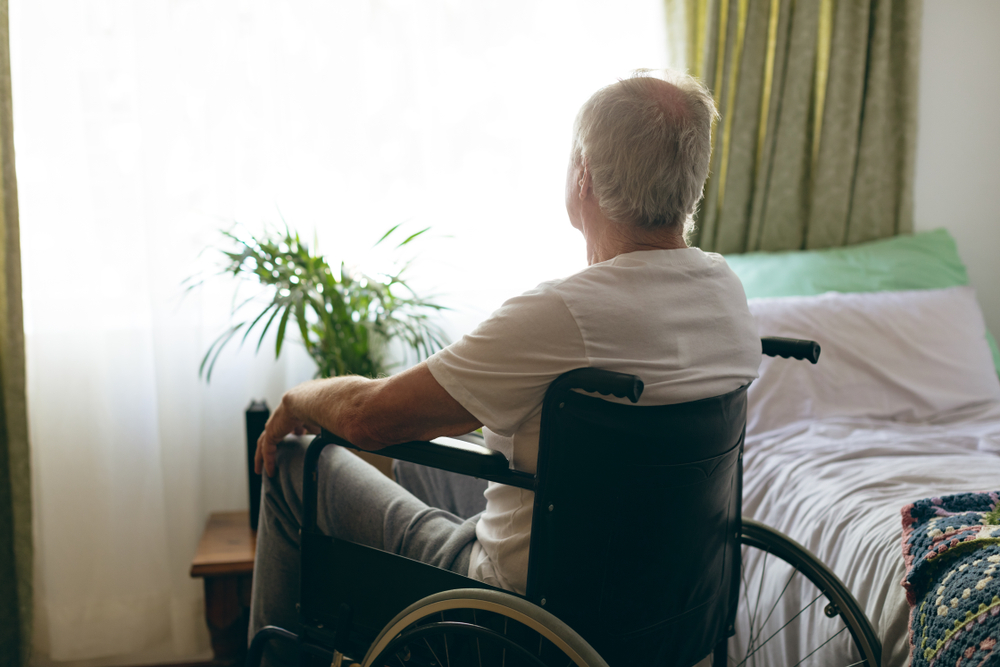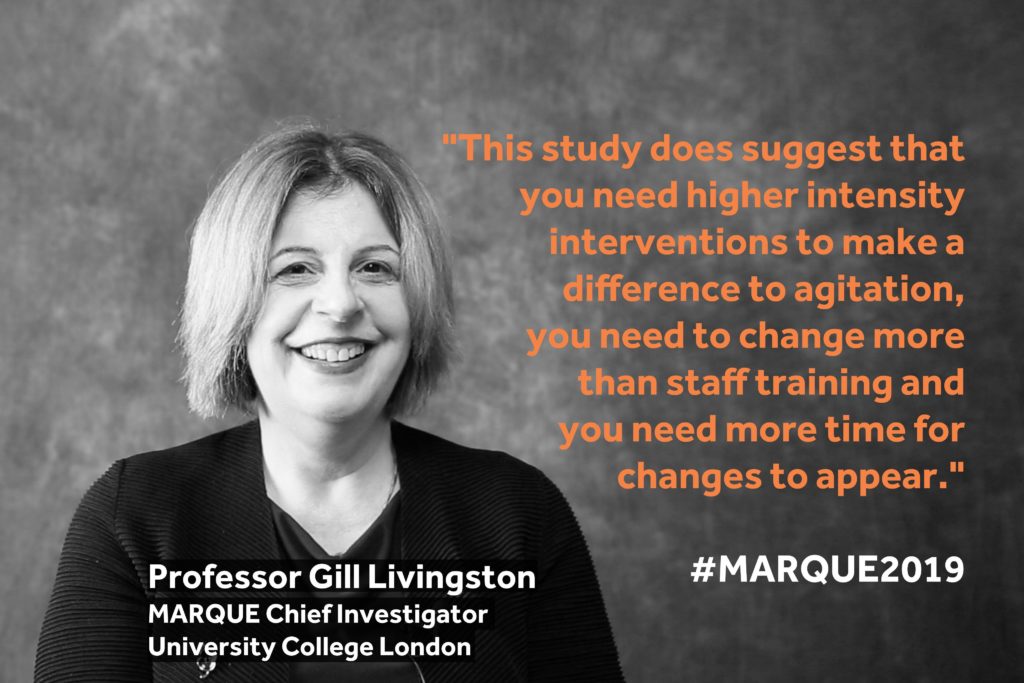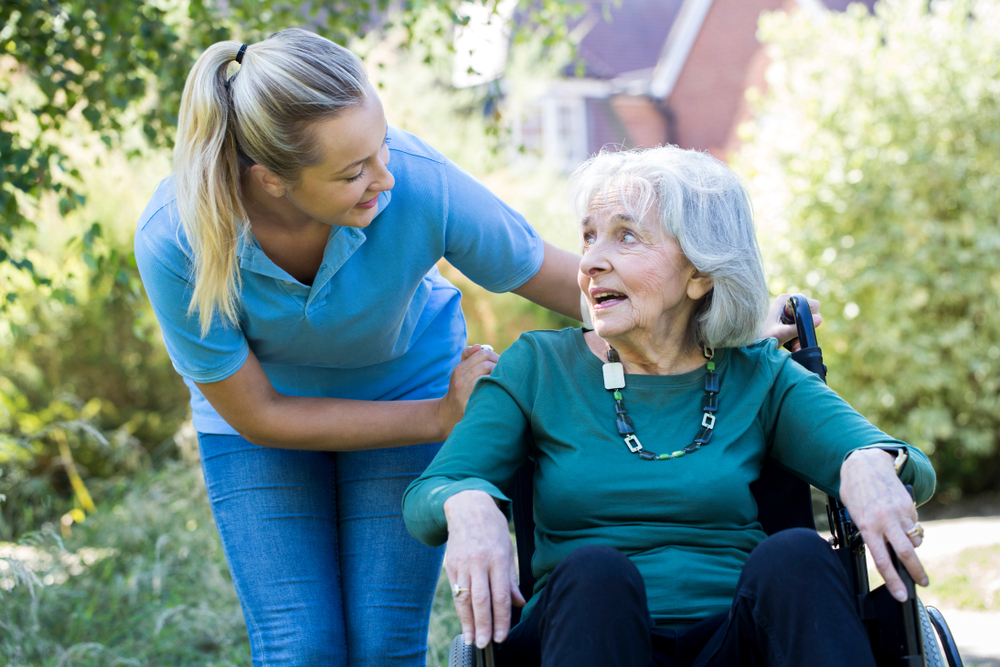
People with dementia often experience agitation, for example restlessness, pacing, and aggression (Cummings et al, 2015) and this can lead to distress for them, their family and carers (Okura et al, 2011).
So far, treatments for agitation in dementia have included social and physical activities in care homes; which are effective but often require specialist training for staff that can be costly and impractical (Rapp et al, 2013; Livingston et al, 2014; Ballard et al, 2018; Lichtwarck et al, 2018).
A team of dementia experts led by Prof Gill Livingston from UCL have developed a treatment to reduce agitation that is aimed at non-specialist staff under supervision, which they’ve called ‘Managing Agitation and Raising Quality of Life in Dementia’ (MARQUE).

People with dementia often experience agitation, (e.g. restlessness, pacing, and aggression) which can lead to distress for them, their family and carers.
Methods
Care home staff members (e.g. care assistants and nurses) were trained on how to respond to agitation in 6 interactive sessions that were focussed on understanding agitation in dementia, improving communication and integrating enjoyable activities into daily care. Staff were supported to develop action plans for their care home and then received monthly support to monitor their progress and help them implement the action plans.
Researchers collected data from residents, families and staff at the start of the study and 8 months later, and the main outcome was an assessment of agitation at the end of the study period7. They also measured neuropsychiatric symptoms (symptoms other than loss of memory, e.g. depression, anxiety and agitation), quality of life, severity of dementia, use of antipsychotic medication and cost effectiveness. Care home staff were asked if they experienced burnout, how competent they felt in their jobs and whether they had committed or witnessed any positive or abusive behaviours towards residents.
20 care homes were involved in this study with a mixture of private and charity homes and they were classified as either residential or nursing homes. They found 767 residents were eligible for the study but only 53% agreed to participate and people who declined were more likely to lack the ability to consent to the study. Half of the care homes were allocated to the MARQUE intervention (training sessions and support) and the remaining homes made no changes to treatment (control group).
Results
After 8 months there were no differences in agitation scores between those who had received MARQUE and control suggesting MARQUE did not reduce levels of agitation in residents with dementia. There was also no improvement in neuropsychiatric symptoms, quality of life and staff burnout, however the data did suggest weak evidence that residents experienced less abusive behaviour from staff and reduced use of antipsychotic medication.
The total cost of the training and delivery of MARQUE was £41,510 (£220 per resident) and the intervention cost £204 more per resident. An economic measure Quality Adjusted Life Year Score (QALYS) which looks at quality and quantity of life lived, was assessed to determine if MARQUE was cost effective. The intervention cost more but there was weak evidence suggesting an overall improvement in QALYS. It is possible that non-participating residents in the care home benefited from the treatment, which would reduce the cost per resident that benefited from MARQUE.

“It is clear from MARQUE that management and staff, though they understand the importance of person-centred care, can struggle to deliver it meaningfully to people living with dementia” – Beach & Thomas (2019).
Conclusions
MARQUE was a carefully designed intervention which was developed by looking a previous studies and interviewing care home staff to identify promising and realistic strategies. This is the first trial to deliver this type of intervention which was practical, relatively straightforward to implement and assessed costs, however there are some limitations that need consideration. These include an unintentional bias in the recruitment of care homes and residents. Many residents considered more agitated by staff did not take part, so these care homes may have lower recorded levels of agitation in this study compared to similar homes and this may have minimised the impact of the treatment. Also, the staff involved in this study reported less burnout than has been seen in similar previous studies so this sample may not be representative of all care homes.
The cost-benefit analysis suggests that MARQUE didn’t provide value for money, but this might be because there wasn’t enough data to find a clear difference. This issue could be overcome with larger studies. The study only followed residents up 8 months later and this may be too short to find a long term positive change.
Other similar interventions did reduce agitation, so why was MARQUE different? The other interventions were time and resource intensive, so whilst they were effective they may have cost a significant amount. The cost-benefit is essential to justify an expansion of this intervention to other services and other studies have not evaluated this; but based on this study, there is no strong evidence to support this expansion.
In conclusion, there is no strong evidence to suggest similar interventions should be used in care homes to reduce agitation. High intensity treatments are needed for this purpose, and these might not be cost effective. Such treatments could include changing shift patterns and daily management of residents with agitation in dementia. Despite its limitations this study has provided a useful insight into the further work required to develop and implement future strategies to reduce agitation and improve quality of life.

“This study does suggest that you need higher intensity interventions to make a difference to agitation, you need to change more than staff training and you need more time for changes to appear” – Prof Gill Livingston, MARQUE Chief Investigator.
Implications
- Previous interventions using more time and resource intensive treatments demonstrated reductions in agitation in care home residents with dementia
- This was a study exploring a care home training programme to develop methods to reduce agitation in residents with dementia through 6 sessions and monthly support following after the sessions
- At 8 months there was no difference in levels of agitation, non-cognitive symptoms of dementia, quality of life or staff burnout, but there was weak evidence that residents experienced less abusive behaviour from staff and reduced antipsychotic medication
- This study has provided an insight into useful strategies to develop in the future.

“When people with dementia and agitation are admitted to care homes, staff are often not able to deliver the quality of care that people would want for their relatives or what the staff members themselves may wish to deliver. Staff are also not regarded as people whose own personhood is important” – Beach & Thomas (2019).
Contributors
Thanks to the UCL Mental Health MSc students who wrote this blog: Georgina Buswell (@GeorgieBuswell) and David Mirfin (@Mirfind).
Conflicts of interest
None.
UCL MSc in Mental Health Studies
This blog has been written by a group of students on the Clinical Mental Health Sciences MSc at University College London. A full list of blogs by UCL MSc students from can be found here, and you can follow the Mental Health Studies MSc team on Twitter.
We regularly publish blogs written by individual students or groups of students studying at universities that subscribe to the National Elf Service. Contact us if you’d like to find out more about how this could work for your university.
Links
Primary paper
Livingston et al (2019). Clinical and cost-effectiveness of the Managing Agitation and Raising Quality of Life (MARQUE) intervention for agitation in people with dementia in care homes: A single blind, cluster-randomised controlled trial. The Lancet https://doi.org/10.1016/S2215-0366(19)30045-8
Bunn F, Handley M. (2019) Commentary: Reducing agitation in care home residents with dementia. The Lancet Open Access Published: March 11, 2019 DOI: https://doi.org/10.1016/S2215-0366(19)30080-X
Other references
Cummings, J., Mintzer, J., Brodaty, H., Sano, M., Banerjee, S., Devanand, D. P., … & Peskind, E. (2015). Agitation in cognitive disorders: International Psychogeriatric Association provisional consensus clinical and research definition. International Psychogeriatrics, 27(1), 7-17.
Okura, T., Plassman, B. L., Steffens, D. C., Llewellyn, D. J., Potter, G. G., & Langa, K. M. (2011). Neuropsychiatric symptoms and the risk of institutionalization and death: the aging, demographics, and memory study. Journal of the American Geriatrics Society, 59(3), 473-481.
Rapp, M. A., Mell, T., Majic, T., Treusch, Y., Nordheim, J., Niemann-Mirmehdi, M., … & Heinz, A. (2013). Agitation in nursing home residents with dementia (VIDEANT trial): effects of a cluster-randomized, controlled, guideline implementation trial. Journal of the American Medical Directors Association, 14(9), 690-695.
Livingston, G., Kelly, L., Lewis-Holmes, E., Baio, G., Morris, S., Patel, N., … & Cooper, C. (2014). Non-pharmacological interventions for agitation in dementia: systematic review of randomised controlled trials. The British Journal of Psychiatry, 205(6), 436-442.
Ballard, C., Corbett, A., Orrell, M., Williams, G., Moniz-Cook, E., Romeo, R., … & Wenborn, J. (2018). Impact of person-centred care training and person-centred activities on quality of life, agitation, and antipsychotic use in people with dementia living in nursing homes: A cluster-randomised controlled trial. PLoS medicine, 15(2), e1002500.
Lichtwarck, B., Selbaek, G., Kirkevold, Ø., Rokstad, A. M. M., Benth, J. Š., Lindstrøm, J. C., & Bergh, S. (2018). Targeted interdisciplinary model for evaluation and treatment of neuropsychiatric symptoms: a cluster randomized controlled trial. The American Journal of Geriatric Psychiatry, 26(1), 25-38.
Cohen-Mansfield, J., Marx, M. S., & Rosenthal, A. S. (1989). A description of agitation in a nursing home. Journal of gerontology, 44(3), M77-M84.
Beach B, Thomas L. (2019) Exploring dementia and agitation: How public policy needs to respond (PDF). International Longevity Centre UK
